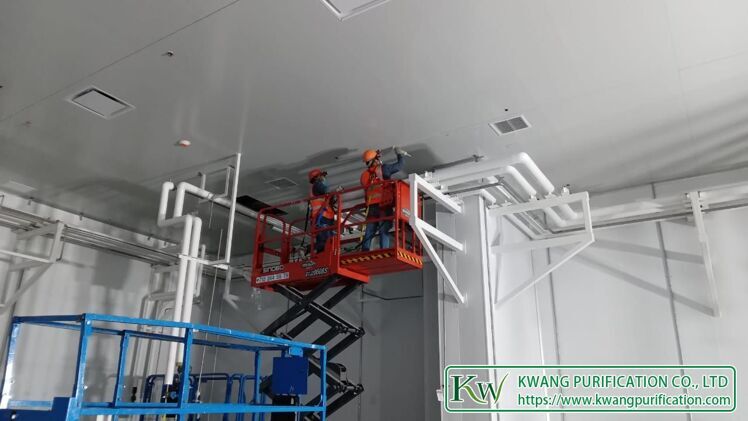Clean Room Manufacturing: Ensuring Precision and Quality
- 2024-01-18
- View 7
Clean room manufacturing has become an integral part of various industries, ranging from semiconductor production to pharmaceuticals and biotechnology. These controlled environments are specially designed to maintain extremely low levels of airborne particles, ensuring precision, quality, and safety in the manufacturing processes. This article will delve into the concept of clean room manufacturing its significance, applications, and the critical role it plays in various sectors.

1. What is Clean Room Manufacturing?
Clean room manufacturing refers to the creation and operation of controlled environments with strict control over airborne particulate contamination, temperature, humidity, and other environmental factors. These rooms are designed to provide a clean and sterile atmosphere, minimizing the risk of product defects and ensuring high-quality manufacturing processes.
2. The Importance of Controlled Environments
In industries where precision and quality are paramount, even the tiniest particles can have significant consequences Clean rooms provide a stable and controlled environment where variations in temperature, humidity, and contamination are kept to a minimum, allowing manufacturers to produce consistent and reliable products.
3. Clean Room Classification and Standards
Clean rooms are classified based on the number of particles present in the air per cubic meter. The ISO standard (ISO 14644-1) is commonly used to determine the cleanliness level of clean rooms, ranging from ISO Class 1 (fewest particles) to ISO Class 9 (highest permissible particle count).
4. Key Components of a Clean Room
4.1 Air Filtration Systems
High-efficiency particulate air (HEPA) or ultra-low penetration air (ULPA) filters are used to remove particles from the air, ensuring that the environment remains clean and sterile.
4.2 HVAC Systems
Heating, ventilation, and air conditioning (HVAC) systems play a crucial role in maintaining the desired temperature, humidity, and air circulation within the clean room.
4.3 Wall and Ceiling Panels
Clean room walls and ceilings are constructed with materials that prevent the generation and retention of particles, minimizing the risk of contamination.
4.4 Flooring and Furniture
Special flooring materials and furniture are used to reduce particle generation and facilitate easy cleaning and maintenance.
5. Applications of Clean Room Manufacturing
5.1 Semiconductor and Electronics Industry
In semiconductor manufacturing, even the tiniest particle can lead to the failure of electronic components. Clean rooms ensure a particle-free environment, enhancing the yield and reliability of integrated circuits.
5.2 Pharmaceutical and Biotechnology Industry
Clean rooms are vital in pharmaceutical and biotechnology research and production, where sterility is crucial for drug development and manufacturing.
5.3 Aerospace and Defense Industry
In aerospace and defense applications, clean rooms are used to assemble and test sensitive components, such as satellites and spacecraft.
5.4 Medical Device Manufacturing
Clean rooms are instrumental in the production of medical devices, ensuring that they meet stringent safety and quality standards.
6. Benefits of Clean Room Manufacturing
6.1 Improved Product Quality
Clean room manufacturing significantly reduces the risk of product defects, leading to higher quality and more reliable products.
6.2 Enhanced Safety for Workers
Workers in clean room environments are protected from hazardous substances, ensuring their safety and well-being.
6.3 Reduced Contamination Risks
The controlled environment of clean rooms minimizes contamination risks, safeguarding critical manufacturing processes.
6.4 Regulatory Compliance
Clean room manufacturing helps industries comply with strict regulatory requirements, ensuring that products meet industry standards.
7. Challenges and Considerations
7.1 Cost of Implementation
Setting up and maintaining clean rooms can be costly, making it essential to weigh the benefits against the expenses.
7.2 Monitoring and Maintenance
Regular monitoring and maintenance are essential to ensure that clean rooms continue to function at their optimal level.
7.3 Training and Certification
Proper training and certification of personnel are necessary to ensure adherence to clean room protocols and procedures.
8. Conclusion
Clean room manufacturing has revolutionized various industries by providing contamination-free environments that ensure precision, quality, and safety. From semiconductor production to pharmaceutical research, clean rooms play a critical role in delivering reliable products that meet stringent industry standards. As technology and innovation continue to advance, the importance of clean room manufacturing will only grow, driving industries toward even higher levels of precision and excellence.
Kwang Cleanroom is proud to offer examples of a variety of our cleanroom projects below. ISO Clean Room, Cleanroom Packaging Services, Clean Room Installation, Dust-Free Room, Dust-Free Clean Room Equipment, Pharmacy Clean Room, Hospital Operating Theater Room.
